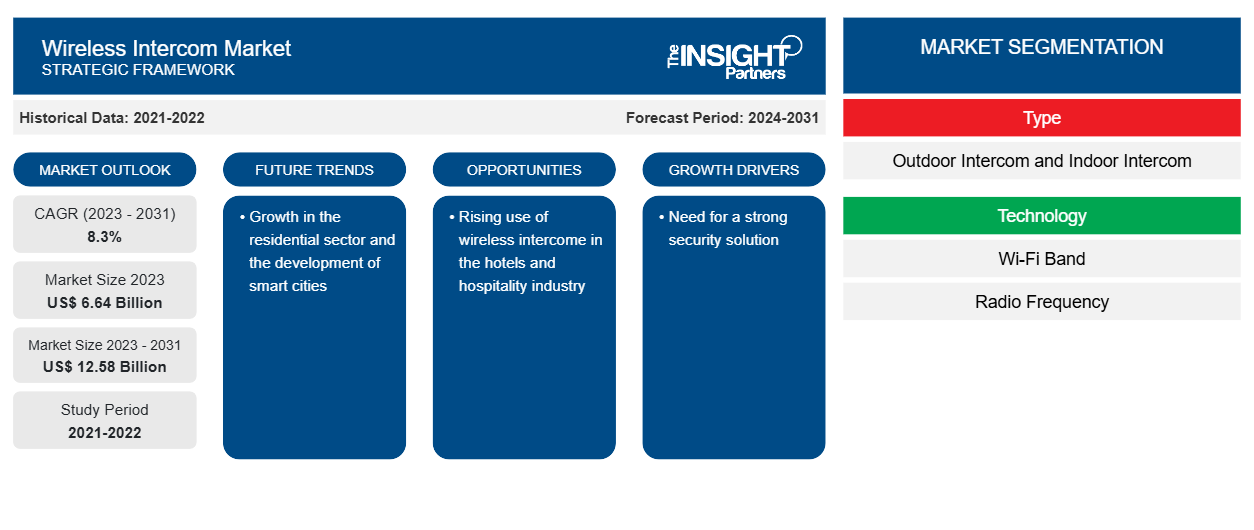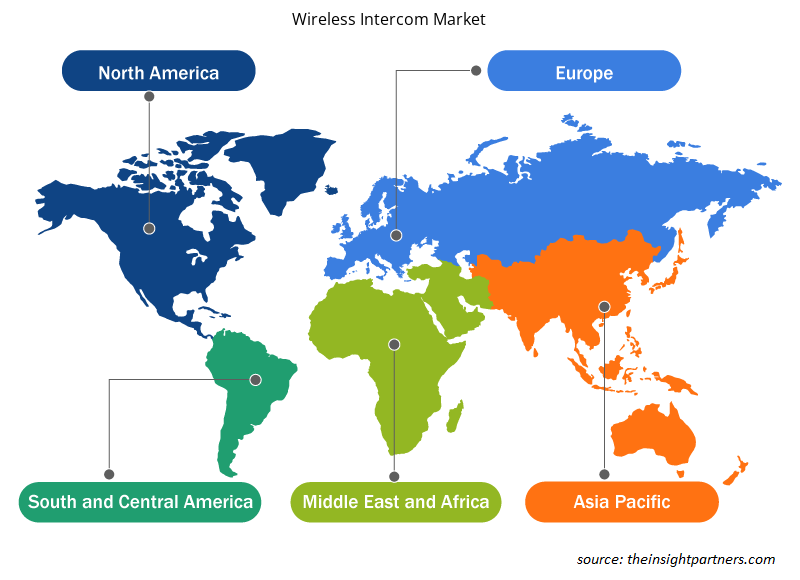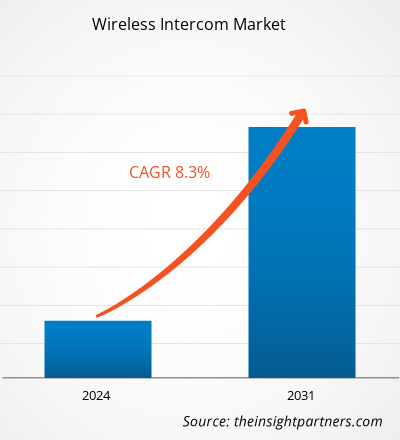The wireless intercom market size is projected to reach US$ 12.58 billion by 2031 from US$ 6.64 billion in 2023. The market is expected to register a CAGR of 8.3% in 2023–2031. The rise in demand for robust security solutions and the increase in demand for Wi-Fi-based wireless intercoms across various industries are likely to remain key to wireless intercom market trends.
Wireless Intercom Market Analysis
The wireless intercom market is experiencing growth worldwide owing to growing popularity of wireless technology. There is a rise in demand for strong security solutions in the residential and commercial sectors which further fuels the market growth. The growing demand for advanced audio and video-based surveillance system to foster security is driving the market growth.
Wireless Intercom Market Overview
A wireless intercom is a electronics device that enables the room-to-room or building-to-building voice communication. The high cost of retrofitting a building to install a wired intercom leads to the installation of wireless intercom. Another reason to use a wireless system is its portability. The demand for wireless intercom system is rising due to the growing demand for solutions to fuel home security systems.
Customize This Report To Suit Your Requirement
You will get customization on any report - free of charge - including parts of this report, or country-level analysis, Excel Data pack, as well as avail great offers and discounts for start-ups & universities
Wireless Intercom Market: Strategic Insights

- Get Top Key Market Trends of this report.This FREE sample will include data analysis, ranging from market trends to estimates and forecasts.
You will get customization on any report - free of charge - including parts of this report, or country-level analysis, Excel Data pack, as well as avail great offers and discounts for start-ups & universities
Wireless Intercom Market: Strategic Insights

- Get Top Key Market Trends of this report.This FREE sample will include data analysis, ranging from market trends to estimates and forecasts.
Wireless Intercom Market Drivers and Opportunities
Need for a strong security solution to Favor Market
There is a rise in demand for robust security solutions across residential and commercial industries, which is driving the wireless intercom market. In recent years, security has become a top priority for businesses and institutions which is leading to the adoption of enhanced security solutions, which further drives the adoption of wireless intercoms. Wireless intercoms provide two-way voice intercom capabilities that enhances the security in the residential and commercial buildings. These systems help for effective communication among security personnel, staff, and management, resulting in timely and coordinated incident responses.
Rising use of wireless intercom in the hotels and hospitality industry
Wireless intercom systems are gaining popularity in hotels owing to their ability to improve safety. These system helps the staff members to enhance their communication and response faster to the guest requests, which in turn improves the guest experience. In addition, these systems optimize the service offering and deliver anytime services. The hotels and hospitality industry demands advanced communication system to improve their customer experiences. Thus, this factor fuels the wireless intercom systems in hotels, combined with the expanding hospitality industry.
Wireless Intercom Market Report Segmentation Analysis
Key segments that contributed to the derivation of the wireless intercom market analysis are type, technology, application, and industry.
- By type, the market is segmented into outdoor intercom and indoor intercom. The indoor intercom segment held the largest market share in 2023.
- Based on the technology, the market is segmented into Wi-Fi band, radio frequency, and others. The others segment held the largest market share in 2023.
- By application, the market is segmented into residential and commercial. The residential segment is expected to grow with the highest CAGR.
- By industry, the market is segmented into hospitality, retail, transportation & logistics, event management, security & surveillance, and others. The security & surveillance segment held the largest market share in 2023.
Wireless Intercom Market Share Analysis by Geography
The geographic scope of the wireless intercom market report is mainly divided into five regions: North America, Asia Pacific, Europe, Middle East & Africa, and South America/South & Central America.
Asia Pacific region is expected to grow with the highest CAGR. With the rise in the electric vehicle market in the region, the demand for robust security solutions generates the need for battery audio and video-based surveillance technology. The rise in the hospitality industry in the region further drives the wireless intercom market growth in the region.
Wireless Intercom Market Regional Insights
The regional trends and factors influencing the Wireless Intercom Market throughout the forecast period have been thoroughly explained by the analysts at The Insight Partners. This section also discusses Wireless Intercom Market segments and geography across North America, Europe, Asia Pacific, Middle East and Africa, and South and Central America.

- Get the Regional Specific Data for Wireless Intercom Market
Wireless Intercom Market Report Scope
| Report Attribute | Details |
|---|---|
| Market size in 2023 | US$ 6.64 Billion |
| Market Size by 2031 | US$ 12.58 Billion |
| Global CAGR (2023 - 2031) | 8.3% |
| Historical Data | 2021-2022 |
| Forecast period | 2024-2031 |
| Segments Covered |
By Type
|
| Regions and Countries Covered | North America
|
| Market leaders and key company profiles |
Wireless Intercom Market Players Density: Understanding Its Impact on Business Dynamics
The Wireless Intercom Market is growing rapidly, driven by increasing end-user demand due to factors such as evolving consumer preferences, technological advancements, and greater awareness of the product's benefits. As demand rises, businesses are expanding their offerings, innovating to meet consumer needs, and capitalizing on emerging trends, which further fuels market growth.
Market players density refers to the distribution of firms or companies operating within a particular market or industry. It indicates how many competitors (market players) are present in a given market space relative to its size or total market value.
Major Companies operating in the Wireless Intercom Market are:
- Alcatel-Lucent S.A. (Nokia Corporation)
- Aiphone Corporation
- Clear-Com LLC
- Commend International GmbH
- Panasonic Corporation
- Riedel
Disclaimer: The companies listed above are not ranked in any particular order.

- Get the Wireless Intercom Market top key players overview
Wireless Intercom Market News and Recent Developments
The Wireless Intercom Market is evaluated by gathering qualitative and quantitative data post primary and secondary research, which includes important corporate publications, association data, and databases. The following is a list of developments in the market:
- In September 2023, Savox Communications, the leading provider of mission-critical hearing protection and communication solutions, launched a game-changing intercom system, which brings a situational Sixth Sense into team operations. The Savox IMPW is an intercom system with wireless capability, designed to withstand the harshest conditions in both civilian and combat missions, ensuring uninterrupted communications. (Source: Savox Communications, Press Release, 2023)
- In January 2024, Axnes AS, a leading provider of innovative wireless intercom communication systems, announced that it had been selected to deliver its cutting-edge PNG Wireless Intercom System (WICS) technology to the UK Ministry of Defence (MOD) for their Puma HC Mk2 Air System. The PNG WICS will be utilized to enhance the aircraft’s communication systems for Search and Rescue (SAR) applications and Human External Cargo (HEC) missions. The Axnes PNG system allows the Puma to meet all (UK/European standard requirements) for two-way radio communication for HEC operations. (Source: Axnes AS, Press Release, 2023)
Wireless Intercom Market Report Coverage and Deliverables
The “Wireless Intercom Market Size and Forecast (2023–2031)” report provides a detailed analysis of the market covering the below areas.
- Market size and forecast at global, regional, and country levels for all the key market segments covered under the scope
- Market dynamics such as drivers, restraints, and key opportunities
- Key future trends
- Detailed PEST/Porter’s Five Forces and SWOT analysis
- Global and regional market analysis covering key market trends, major players, regulations, and recent market developments
- Industry landscape and competition analysis covering market concentration, heat map analysis, prominent players, and recent developments
- Detailed company profiles
Frequently Asked Questions
What will be the market size of the global wireless intercom market by 2031?
The global wireless intercom market is expected to reach US$ 12.58 billion by 2031.
Which are the key players holding the major market share of the global wireless intercom market?
The key players holding majority shares in the global wireless intercom market are Alcatel-Lucent S.A. (Nokia Corporation), Aiphone Corporation, Clear-Com LLC, Commend International GmbH, and Panasonic Corporation.
What is the incremental growth of the global wireless intercom market during the forecast period?
The incremental growth expected to be recorded for the global wireless intercom market during the forecast period is US$ 5.94 billion.
What is the estimated market size for the global wireless intercom market in 2023?
The global wireless intercom market was estimated to be US$ 6.64 billion in 2023 and is expected to grow at a CAGR of 8.3% during the forecast period 2023 - 2031.
What are the driving factors impacting the global wireless intercom market?
The rise in demand for robust security solutions and increase in demand for Wi-Fi based wireless intercom across various industries are the major factors that propel the global wireless intercom market.
What are the future trends of the global wireless intercom market?
Growth in the residential sector and the development of smart cities is anticipated to play a significant role in the global wireless intercom market in the coming years.
- Historical Analysis (2 Years), Base Year, Forecast (7 Years) with CAGR
- PEST and SWOT Analysis
- Market Size Value / Volume - Global, Regional, Country
- Industry and Competitive Landscape
- Excel Dataset
Testimonials
Reason to Buy
- Informed Decision-Making
- Understanding Market Dynamics
- Competitive Analysis
- Identifying Emerging Markets
- Customer Insights
- Market Forecasts
- Risk Mitigation
- Boosting Operational Efficiency
- Strategic Planning
- Investment Justification
- Tracking Industry Innovations
- Aligning with Regulatory Trends
Yes! We provide a free sample of the report, which includes Report Scope (Table of Contents), report structure, and selected insights to help you assess the value of the full report. Please click on the "Download Sample" button or contact us to receive your copy.
Absolutely — analyst assistance is part of the package. You can connect with our analyst post-purchase to clarify report insights, methodology or discuss how the findings apply to your business needs.
Once your order is successfully placed, you will receive a confirmation email along with your invoice.
• For published reports: You’ll receive access to the report within 4–6 working hours via a secured email sent to your email.
• For upcoming reports: Your order will be recorded as a pre-booking. Our team will share the estimated release date and keep you informed of any updates. As soon as the report is published, it will be delivered to your registered email.
We offer customization options to align the report with your specific objectives. Whether you need deeper insights into a particular region, industry segment, competitor analysis, or data cut, our research team can tailor the report accordingly. Please share your requirements with us, and we’ll be happy to provide a customized proposal or scope.
The report is available in either PDF format or as an Excel dataset, depending on the license you choose.
The PDF version provides the full analysis and visuals in a ready-to-read format. The Excel dataset includes all underlying data tables for easy manipulation and further analysis.
Please review the license options at checkout or contact us to confirm which formats are included with your purchase.
Our payment process is fully secure and PCI-DSS compliant.
We use trusted and encrypted payment gateways to ensure that all transactions are protected with industry-standard SSL encryption. Your payment details are never stored on our servers and are handled securely by certified third-party processors.
You can make your purchase with confidence, knowing your personal and financial information is safe with us.
Yes, we do offer special pricing for bulk purchases.
If you're interested in purchasing multiple reports, we’re happy to provide a customized bundle offer or volume-based discount tailored to your needs. Please contact our sales team with the list of reports you’re considering, and we’ll share a personalized quote.
Yes, absolutely.
Our team is available to help you make an informed decision. Whether you have questions about the report’s scope, methodology, customization options, or which license suits you best, we’re here to assist. Please reach out to us at sales@theinsightpartners.com, and one of our representatives will get in touch promptly.
Yes, a billing invoice will be automatically generated and sent to your registered email upon successful completion of your purchase.
If you need the invoice in a specific format or require additional details (such as company name, GST, or VAT information), feel free to contact us, and we’ll be happy to assist.
Yes, certainly.
If you encounter any difficulties accessing or receiving your report, our support team is ready to assist you. Simply reach out to us via email or live chat with your order information, and we’ll ensure the issue is resolved quickly so you can access your report without interruption.





















 Get Free Sample For
Get Free Sample For